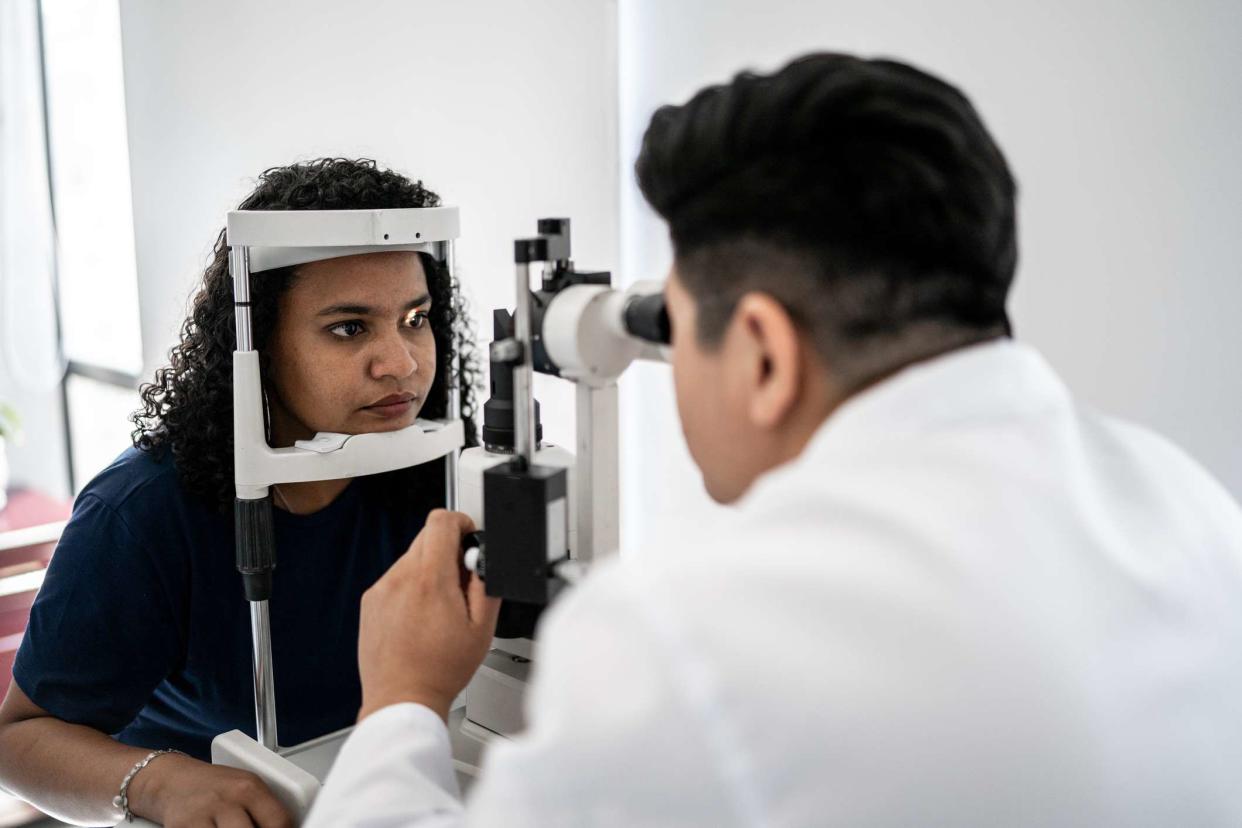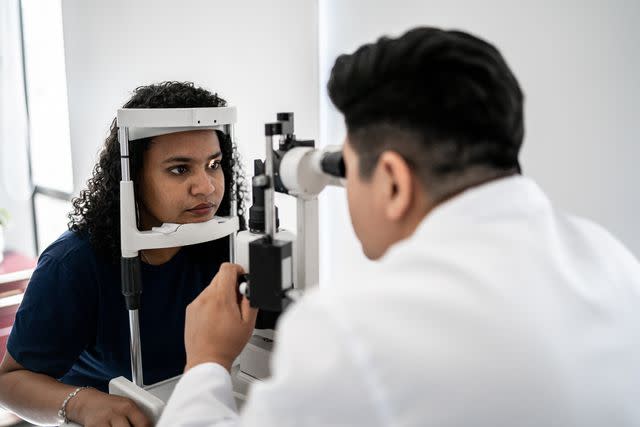What Is Retinitis Pigmentosa?

FG Trade / Getty Images
Medically reviewed by Bryan M. Wolynski, OD
Retinitis pigmentosa (RP) is a genetic eye disease that causes the retina to break down. With retinitis pigmentosa, the light-sensitive retina slowly deteriorates.
Symptoms usually start in childhood due to genetic causes. As the retina begins to degrade, night vision problems occur before progressing to a slow loss of peripheral (side) vision. Over time, this leads to blindness. Currently, there is no cure for this chronic, progressive condition.
In this article, you will learn about what puts you at risk for retinitis pigmentosa, symptoms to watch for, related health issues, and how you can maximize vision.

FG Trade / Getty Images
Who Inherits Retinitis Pigmentosa?
Retinitis pigmentosa typically runs in families, affecting those who have inherited a flawed gene copy from one parent. Over 100 different genes can lead to retinitis pigmentosa.
Typically, symptoms of retinitis pigmentosa first occur in childhood, but may only become noticeable in adulthood. The first detection of symptoms often occurs between ages 10 and 30.
Retinitis pigmentosa impacts about 1 in 400 people in the United States. Family history is the number one risk factor. Males are also more likely to be affected than females.
(Note that when health authorities and research are cited, the terms for sex or gender from the source are used.)
Retinitis Pigmentosa Symptoms and Vision Changes
The retina consists of cells sensitive to light called rods and cones. The cones are responsible for seeing color and are located mainly in the center of the light-sensitive retina at the back of the eye. The rods are used chiefly for dim light and are located on the side of the retina.
In retinitis pigmentosa, the rods are affected by a genetic mutation, but the cones can also die for unknown reasons.
Most types of retinitis pigmentosa involve the rods, causing vision problems in darkened conditions and trouble seeing things in the periphery. However, in cases in which it affects the cones, color vision and sharp central vision decline.
Parents may notice their child having difficulty adjusting to dim conditions, which can progress to loss of night vision. The child may also have issues navigating obstacles in the dark. In other cases, glare in bright conditions may be an issue.
The condition is a progressive one, meaning it worsens over time. Most people don't lose all of their vision, but because their degree of sight can become very restricted, their eye doctor, such as an ophthalmologist or optometrist, may proclaim them legally blind. This is because even though they may keep good central vision, which allows them to see details, their peripheral vision may be poor.
Other symptoms to watch for include the following:
Difficulty seeing on stormy or foggy days
Trouble seeing specific colors, blue in particular
Experiencing tunnel vision, in which the visual field narrows, and you lose side vision
Progressive vision loss that occurs gradually and may affect all or just some sight
Secondary Effects of Retinitis Pigmentosa
Vision loss may not be the only issue with retinitis pigmentosa. If you have another genetic condition, retinitis pigmentosa may be just one part of it. Usher syndrome, which includes vision loss, also causes hearing issues and sometimes problems with balance.
Those with Usher syndrome fall into different types. In Usher syndrome type 1, infants start with severe hearing loss and begin to have problems with balance. Usually around early adolescence, those with type 1 also begin to have trouble seeing at night and with peripheral vision loss.
In type 2 Usher syndrome, infants are moderately to severely hearing impaired. They start to have retinitis pigmentosa issues shortly after adolescence begins. At this time, vision doesn't deteriorate as fast, and hearing tends to remain more consistent.
Meanwhile, those with Usher syndrome type 3 have only mild hearing loss in infancy. But around puberty, their hearing and vision loss become progressive, and they may also have balance issues.
Those with Bardet-Biedl syndrome have obesity and retinitis pigmentosa. Early on, they have issues seeing in low light. Peripheral vision also begins to fade. As children with this syndrome get older, they can also start to lose their central vision.
Those with Bardet-Biedl syndrome can have extra fingers and toes, with some webbing (extra skin connecting the digits). They may, in some cases, experience developmental delays and kidney disease.
Testing to Diagnose Retinitis Pigmentosa
To help determine if you or your child has retinitis pigmentosa, your eye doctor can start by doing a comprehensive exam in which they dilate (widen) the pupil using eye drops and look inside the eye. The eye doctor then examines the retina to look for signs of retinitis pigmentosa, such as the appearance of bone spicules (extra bone called bone spurs or ledges along the edges of bones) to the peripheral retina. They will also do a visual field test to assess for any blind spots in the periphery.
The eye doctor may also perform the following imaging tests:
Optical coherence tomography (OCT): Shining a light beam into the eye, OCT can create a detailed image from what the tissue reflects at varying depths.
Electroretinography (ERG): The test measures the eye's electrical response to light to check on the retinal rods and cones.
Fundus autofluorescence (FAF): A layer of the retina contains a substance that can absorb a blue light wavelength and then give off yellow or green light depending on how intact the retina is.
In addition, if you have retinitis pigmentosa, the eye doctor may recommend genetic testing to determine what form you have. It is essential to know this to understand better how the condition will progress and if there are any potential treatments.
Retinitis Pigmentosa Treatment
There's no cure for retinitis pigmentosa or treatment to prevent it from progressing. Issues that tend to be more common in retinitis pigmentosa cases, such as cataracts (clouding of the lens), can often be treated.
Low-vision aids like magnifiers and anti-glare glasses can also help maximize your vision. If your peripheral vision is compromised, you may benefit from unique eyeglasses that expand side vision with the aid of prisms that bend light in the lenses. This may help minimize vision loss. Using a reverse telescope can help expand your visual field.
You also may benefit from orientation and mobility training with a white cane for nighttime use in the initial stages of worsening vision.
Some research suggests that taking vitamin A or fish oil and lutein supplements may help to slow progression in some cases. But talk to your ophthalmologist first since taking too much vitamin A can cause liver damage.
Scientists are conducting promising research into gene treatments, cell therapy, and medication to prevent vision loss and possibly even restore some vision.
However, it's not possible to transplant the light-sensitive retina, which is damaged in retinitis pigmentosa.
Retinitis Pigmentosa Resources and Support
While managing retinitis pigmentosa can be challenging, programs can help with the transition. Online resources include the following:
Rare Disease Educational Support Program: People with retinitis pigmentosa may be able to attend conferences and other programs to learn more about this disease. The program is open to patients, families, and caregivers. It offers financial support for registration and assistance with related travel and lodging. All applicants must be U.S. citizens or have permanent residence for at least six months.
Find Clinical Trials: This tool enables you to participate in studies for potential retinitis pigmentosa treatments. For this, you will want to know the form of retinitis pigmentosa that you have since treatments tend to be targeted.
Find Specialists: Contact the Genetic and Rare Diseases information center to locate retinitis pigmentosa specialists in your area.
VisionAware Service Directory: The directory provides everything from state outreach programs to local counseling listings to assist those with low-vision needs.
Summary
Retinitis pigmentosa is usually a hereditary condition. The progressive disease often affects peripheral vision, in which the visual field narrows. While those with this condition may keep some vision, over time, they may be classified as legally blind due to the limited visual field. This condition has no cure yet, but genetic research may provide answers.

